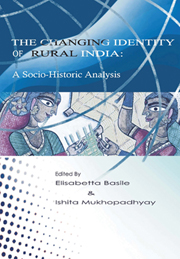Book contents
- Frontmatter
- Contents
- Acronyms and Abbreviations
- About the Authors
- INTRODUCTION
- PART 1 INDIAN RURAL TRANSFORMATIONS
- PART 2 INEQUALITY IN RURAL INDIA
- PART 3 SOCIAL MOVEMENTS AND IDENTITIES
- The Social Context of Politics in Rural West Bengal (1947–92)
- Agrarian Expansion under Colonial Rule and its Impact on a Tribal Economy
- Acting on Institutions to Preserve Agricultural Biodiversity: The Syngenta Controversy in Chhattisgarh
- The Conflicting Opinions of the Colonial Bureaucracy over the Paraiyans Right over ‘Waste’ in late 19th Century Tamil Nadu
- Appendix 1 Socio-Economic Indicators of Rural India
The Social Context of Politics in Rural West Bengal (1947–92)
from PART 3 - SOCIAL MOVEMENTS AND IDENTITIES
Published online by Cambridge University Press: 05 March 2012
- Frontmatter
- Contents
- Acronyms and Abbreviations
- About the Authors
- INTRODUCTION
- PART 1 INDIAN RURAL TRANSFORMATIONS
- PART 2 INEQUALITY IN RURAL INDIA
- PART 3 SOCIAL MOVEMENTS AND IDENTITIES
- The Social Context of Politics in Rural West Bengal (1947–92)
- Agrarian Expansion under Colonial Rule and its Impact on a Tribal Economy
- Acting on Institutions to Preserve Agricultural Biodiversity: The Syngenta Controversy in Chhattisgarh
- The Conflicting Opinions of the Colonial Bureaucracy over the Paraiyans Right over ‘Waste’ in late 19th Century Tamil Nadu
- Appendix 1 Socio-Economic Indicators of Rural India
Summary
The impact of caste on Indian politics is now an established theme in the writings on contemporary India, and has moved scholars to search the colonial past for the roots of contemporary phenomena such as the transformation of caste and the emergence of caste-based parties and political movements in various regions of India. Bengal, however, has remained largely absent from this endeavour. The caste factor here has not been taken into account elaborately as a separate subject, with the notable exception of a few studies on marginal or ‘untouchable’ communities, such as the Namasudras of East Bengal in the colonial period, or on the role played by the constitutional categories of Scheduled Castes and Scheduled Tribes (SC/ST) in the post-independent social and electoral scenario. The largely prevailing approach in works on history and political science focuses on urban politics, ideological confrontations and party struggles, where economic status and education are the really important social variables. These readings seem to imply that caste has (thankfully?) become irrelevant in Bengal society.
Anthropological studies, on their part, have not failed to describe social structures in rural areas in terms of community groups well into the 1980s. We get information on the social status, economic function and political involvement of Brahmans, Kayasthas, Sadgops, Bagdis and other castes in different districts and at different points in time. This time, West Bengal with its specificities does not seem to represent an isolated cluster in the complex mosaic of Indian society.
- Type
- Chapter
- Information
- The Changing Identity of Rural IndiaA Sociohistoric Analysis, pp. 199 - 228Publisher: Anthem PressPrint publication year: 2009



